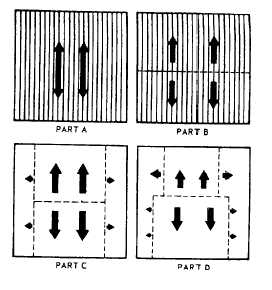| |
the number of different commodities. In a sec-
tion where one item fills the entire area, the sec-
tion should be stacked to its capacity, leaving only
enough space to “get at” it and permit access for
fire prevention or fire-fighting purposes.
CROSS AISLES.— Cross aisles are passage-
ways at right angles to main aisles. At least two
cross aisles are needed in the standard warehouse
section. Where possible, cross aisles should be laid
out so that they will lead directly to opposing
doors of the warehouse. Most storage operations
are carried on in the cross aisles.
PERSONNEL AISLES.— Personnel aisles are
those used as pedestrian routes only. Personnel
aisles should be held to a minimum. Too many
deprive you of valuable storage space and at the
same time encourage pilferage since they are
usually secluded.
FIRE AISLES.— Fire aisles are necessary in
every depot or storage activity, but should be kept
to a minimum in number and width, since they
waste valuable storage space. It is seldom
necessary to have fire aisles wider than 24 inches.
In many cases they can be eliminated by a simple
change in the location of fire-fighting apparatus.
Fire aisles must be adjacent to windows that can
be used by firemen to gain entrance.
SERVICE AISLES.— Services aisles are nor-
mally used for only special commodities of
material. They provide access to the interiors of
stacks for protective processing, inventory, and
inspection.
Direction of Storage
Use of the fork truck and pallet system makes
direction of storage a significant factor in space
use. Selection of the proper direction of storage
can be invaluable in providing a variety of bay
sizes without increasing the number of working
aisles. At the same time, such planning tends to
spread the volume of traffic equally over all work-
ing aisles, relieving congestion. This concept is
illustrated by the diagrams in figure 7-7 that
develop layout in respect to direction of storage
for a bay 80 square feet, a typical bay for large-
lot storage in a standard warehouse. Using stan-
dard 48- by 48-inch pallets, about 17 pallets can
be stored in each direction.
Single Item Stored Aisle
to Aisle
The simplest but most inflexible disposition
of storage space is storage of a single item aisle
to aisle shown by part A of figure 7-7. This layout
makes no provision for storage of small lot items,
which practically every warehouse has.
Miscellaneous Commodities
Numerous articles are shipped in bales and
consequently should be stored in the same
manner. Some are baled even and solid; others
are irregular and slack. The size of the bale varies
with the commodity. Be careful not to break the
strapping. One broken strap on tightly com-
pressed bales will put extra strain on the other
straps and may cause the bale to break open. Firm
bales can be palletized and piled as safely as cases.
Slack bales that cannot be palletized should be
tiered and tied in with dunnage.
Various commodities such as flour and sugar
are shipped in burlap or waterproof paper con-
tainers. Nails, bolts, or sharp edges should be
eliminated in areas where bagged goods are to be
stored. If these hazards cannot be removed, the
bags should be protected with dunnage. If a bag
is broken, it should be plugged with a piece of
paper and sewn.
Bags containing perishables or “subject to
taint” commodities should be stored on clean, dry
dunnage or pallets. Use separating paper with
such commodities. Keep them away from odorous
commodities—tarred rope, for example.
Figure 7-7.—Principles of working aisle arrangements.
7-20
|

